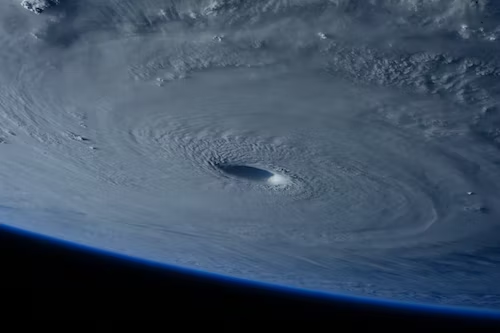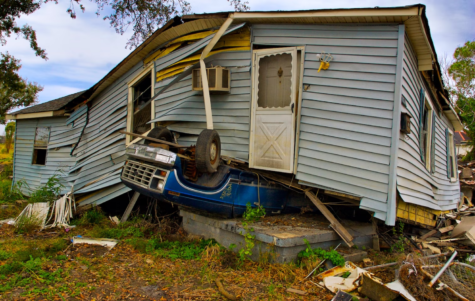The Future of Hurricanes
Are hurricanes ever going to be countered by science? Or will they forever be a source of destruction for humanity?

Published in 2016, this image taken from outer space reveals the truly massive reach of a hurricane on earth; the tropical winds from a hurricane can reach hundreds of miles from the center.
Nobody likes hurricanes. Heralded as reapers of death and demolishers of cities, they are feared as the worst of nature’s three watery disasters, deadlier than tsunamis and floods. As a result, scientists have been trying to decipher the patterns behind hurricane creation and movement, in order to be able to determine when future storms will hit and how destructive they will be.
To this end, there have been many important breakthroughs in hurricane technology, including the inventions of special devices and methods of observations. Scientists have also looked for ways to possibly prevent hurricanes from forming. However, recent studies indicate that hurricanes are here to stay.
What are Hurricanes?
Hurricanes, also called cyclones and typhoons, are some of nature’s most destructive forces, having the ability to wreak destruction over entire cities in just a few days. Since ancient times, hurricanes have been feared due to their ability to harness the power of water and air to create a deadly flood that can wipe out people, crops, animals, and buildings.
Recently, hurricanes have been getting more destructive, as seen by the increase in the occurrence of Category 4 and 5 hurricanes.
According to NASA, hurricanes are a combination of a few factors, mainly the warmth and moisture of the water and air, the vertical wind shear (the concurrence of the wind speed at both the top and bottom of a hurricane), and the existence of storms already in the area.
Since they mainly form in the Atlantic region – the Caribbean and other tropical areas – an increase in temperature due to global warming would potentially decrease the chances of a successful storm forming due to the absence of cool air.
Just as climate change will ensure the average temperatures at sea level increase, the temperatures at higher altitudes will also increase, meaning that the entire vertical component of the cyclone will have balanced pressure on the top and bottom.
A streamlined mode of travel helps the hurricane to reach the mainland faster. Thus, the storm, which would have only been a mild tropical cyclone over water, ends up reaching land more quickly than expected and causes more destruction.
Hurricane Classification
The more destruction that a hurricane causes, the higher it is rated on the Saffir-Simpson Hurricane Wind Scale, which measures a storm’s highest possible wind speed and the estimated total damage in dollars. Category 4 and Category 5 hurricanes are the worst types by these standards.
The rise in these types of storms supports the idea that as temperature rises, the chances of a hurricane growing stronger increase greatly.
The last factor, the pre-existence of another storm, also contributes to a hurricane’s maximum threat level. Hurricanes are essentially water tornadoes, albeit with more strength.
Hurricane Trends
Another part of the destruction that hurricanes bring is their storm surge, or the amount of water that is released after the hurricane enters the mainland.
Storm surges have drastically increased in recent decades, as shown in data from the Insurance Information Institute (III). The III illustrates the trends of hurricane damage in recent years; five out of the top ten deadliest hurricanes in the last three decades happened within the last five years alone, and also happened to be the costliest hurricanes – altogether, these storms caused around a hundred and fifty million dollars worth of damage, adjusted for inflation.

Tom Knutson, a senior scientist of hurricanes and climate change, said that, “In addition, … models show increases in a hurricane’s rainfall rate by 2100. This means that hurricanes are likely to cause more intense rain when they come ashore” (Colbert, 2022). Knutson’s comment illustrates that hurricanes can create a variety of problems, especially when coupled with the fact that hurricanes will “self-destruct,” or release all their water onto land, when they run out of ocean to navigate.
Knutson also explains that, “While most models show either no change or a decrease in hurricane frequency in a warmer climate, a greater proportion of the storms that form will reach very intense (Category 4 or 5) levels,” (Colbert), further explaining the general trends that are expected to continue in the future; more of these storms will be reaching catastrophic levels, although they will slowly dwindle.
Statistics from the National Hurricane Center also point to these conclusions –- the lower the frequency of storms overall, the higher the frequency of deadly storms will be.
Martin Trek, a teacher in the Physical Science department at The Bronx High School of Science, explains how hurricanes will continue to exist.
“Global warming will move hurricanes around, perhaps, introducing storms to new areas as of yet untouched, and in specific areas the geometry of which may contribute to more severe storms, but will, by and large, weaken them over time. Clouds need cooler temperatures to form, and the hotter the earth gets the further up clouds have to get to find cloud-forming temperatures. It’s actually an additional positive feedback loop – the hotter it gets, the fewer storms and precipitation,” Trek said. Although global warming will theoretically decrease hurricane frequency, it will introduce them to previously unharmed areas, and end up spreading the disaster to more frontiers.
Hurricane Technology
Six main technologies are employed in tracking hurricanes. Buoys, ships, satellites, radiosonde devices, reconnaissance aircraft, and Doppler radar are used to detect and predict hurricanes, which helps scientists prepare for any incoming catastrophe.
Powerful computers and imaging software are then used to map the data onto a simulation that can help to show forecasted paths of the storms.
All of these receiving technologies center around sonar and other methods of slight vibration perception. However, even these highly sophisticated devices cannot solve the issue of hurricane creation.
As Trek said, “Meteorology models currently have around 200 years of data and still can not predict those values accurately. The limits of these models isn’t so much the technology as it is the data itself – we don’t have enough detailed information on weather conditions everywhere in the world to accurately predict things better than we do. Basically, the models need money, not tech.”
The limits of these technologies themselves are not the main issue in our inability to get rid of hurricanes; rather, it is our allocation of resources – if the governments of the world were to spend more time and money collecting data on hurricanes, scientists would have more information with which to work, in order to create more accurate models to predict possible future hurricanes.
Although we have data that is quite detailed, it seems the search for knowledge that can predict and combat hurricanes is still in need of improvement. For now, simply keeping tabs on them is an undertaking in and of itself, and will serve its purpose to a great length.
Storm surges have drastically increased in recent decades, as shown in data from the Insurance Information Institute (III). The III illustrates the trends of hurricane damage in recent years; five out of the top ten deadliest hurricanes in the last three decades happened within the last five years alone, and also happened to be the costliest hurricanes – altogether, these storms caused around a hundred and fifty million dollars worth of damage, adjusted for inflation.
Kareem Malik is a Sports Editor for ‘The Science Survey,’ Kareem believes that the best story is a captivating one that continues to affect you long...
